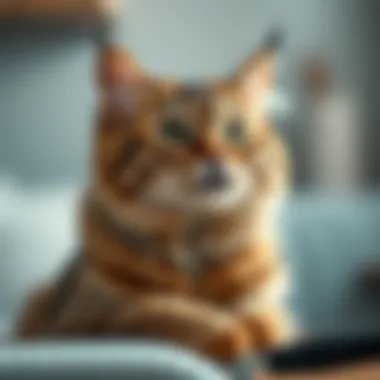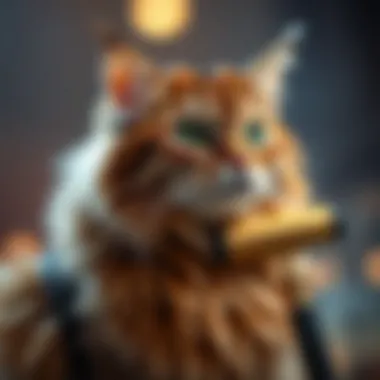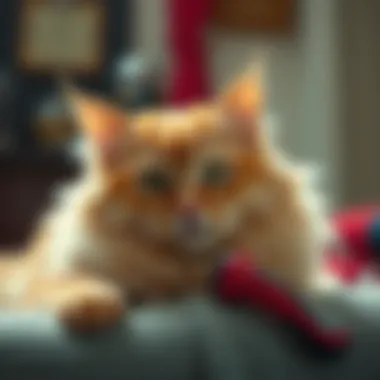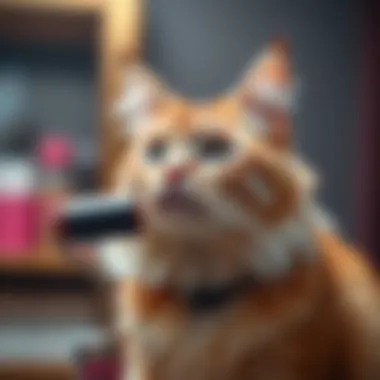A Guide to Removing Cat Hair Effectively with Rollers


Intro
Felines can add a touch of charm to any home, but they also come with their own set of hurdles, particularly when it comes to keeping your wardrobe and living spaces free of pesky cat hair. If you've ever found yourself battling fur on your favorite black sweater or trying to keep your car seat presentable, you're not alone.
As cat owners, many of us find it’s a daily struggle, and the quest for effective hair removal methods can often feel overwhelming. One practical solution that stands out is the use of rollers, which are designed specifically for lifting and collecting pet hair from various surfaces.
This guide aims to break down the nuances of effective cat hair removal using rollers, discussing the different types available and how they stack up in terms of effectiveness. We'll also delve into the care and maintenance of fabrics, addressing the common worries that pet owners face. After all, protecting your clothing and fabric choices doesn't just enhance your appearance; it preserves your investment in quality garments.
With a focus on practical techniques and useful insights, this article hopes to arm you with knowledge that can elevate your cleaning routine and help sustain a quality wardrobe even when living with our furry friends.
We'll explore different types of rollers, ideal techniques for their usage, and even touch on alternative methods that you might not have considered before. So, let’s dive right in and roll away those worries!
Understanding Cat Hair Dynamics
Understanding the dynamics of cat hair is essential for anyone involved in fashion, design, or even everyday living with felines. Cats are not just delightful companions; they bring unique challenges, particularly in the realm of maintaining fabric cleanliness. Navigating the complexities of cat hair can make or break your relationship with fabrics. Whether you’re a designer creating the latest runway trends or a pet owner striving for a tidy home, knowing how cat hair behaves and why it sheds is fundamental to effective management.
The Anatomy of Cat Hair
Cat hair is far more sophisticated than it appears at face value. Each strand is a microscopic marvel, comprising a central shaft surrounded by a protective barrier called the cuticle. The cuticle's purpose is twofold: it provides insulation and contributes to the unique texture of a cat’s fur. Most cats have three types of hair: guard hairs, awn hairs, and down hairs.
- Guard Hairs: These are the long, coarse hairs that form the outer layer, protecting the softer layers beneath. They help repel dirt and moisture.
- Awn Hairs: Medium-length hairs that provide additional insulation.
- Down Hairs: Soft, short hairs that lie closest to the skin.
This combination allows cats to regulate their body temperature effectively, but it also means they are prone to shedding all these different types throughout the year.
Why Cats Shed
Shedding is a natural process for cats, and understanding the reasons behind it can provide insight into managing the fallout. One primary reason cats shed is to maintain their body temperature. During warmer months, shedding helps them acclimate to heat.
Additionally, a cat's health significantly affects shedding. Stress, allergies, or poor diet can lead to excessive hair loss. Incidents of shedding can act as a thermometer for your feline’s well-being, signaling when it might be time to check in with a veterinarian. Regular grooming can mitigate copious hair loss, enabling you to keep your home and wardrobe in order.
Seasonal Shedding Patterns
Cats don’t follow a strict shedding season, but many tend to shed more in spring and fall as they adapt to temperature changes. During these periods, the fur transitions from a dense winter coat to a lighter summer coat, and vice versa. On a practical level, pet owners are often unprepared for such surges in hair production.
Here's a basic outline of seasonal patterns:
- Spring Shedding: Your cat is ditching the heavy fur of winter, resulting in clumps of hair around your living space.
- Fall Shedding: Cats prepare for the cold by growing a thicker coat, but this also means increased shedding.
Proper awareness of these patterns can help you anticipate needs for extra cleaning tools and time management, especially in preparation for the changing seasons.
"Understanding the intricate layers of cat hair dynamics ensures a more harmonious life with our feline friends."
Overview of Cat Hair Rollers
When it comes to keeping your clothing and home free of cat hair, understanding the world of cat hair rollers is indispensable. These tools come into play as practical allies against the persistent fur clouds that accompany our feline friends. The importance of rollers transcends mere aesthetics—they are integral for maintaining the look and feel of your fabrics while enhancing your overall living space's cleanliness. With various options available, each having its own set of characteristics, it’s essential to be well-informed to maximize their effectiveness in hair removal.
Types of Cat Hair Rollers
Cat hair rollers can be broadly categorized into three main types, each bringing unique benefits to the table:
Sticky Rollers
Sticky rollers are the classic choice for many pet owners. These rollers typically come with a coating of adhesive on their surface that effectively captures hair, lint, and dust with each swipe. The key characteristic of sticky rollers lies in their simplicity and immediate effectiveness. With just a quick flick, you can remove pet hair from a variety of surfaces, making them a beneficial option for quick clean-ups. However, one disadvantage is that they rely on replacing the sticky sheets constantly, which could become costly over time.
"Stickiness is not just about how effective it is; it is also about convenience."


Reusable Fabric Rollers
The reusable fabric rollers present a more sustainable approach to cat hair management. They often consist of a textured surface that can be washed and reused multiple times, significantly reducing waste. A major strength of these rollers is the cost-effectiveness over time as you won’t need to constantly buy sticky sheets. However, a unique feature worth mentioning is the need for frequent cleaning, which can sometimes be a hassle depending on how much hair your pet sheds.
Electric Rollers
Electric rollers, often seen as the next-level tool in cat hair removal, offer a speedy alternative to both sticky and fabric rollers. These devices utilize a powerful suction mechanism or rotating brushes to lift away hair from surfaces without much effort. Key aspect of electric rollers is their ability to handle larger areas or more substantial hair accumulations. Although they can be pricier than manual options, their efficiency makes them a popular choice among those looking for quick and effective cleaning solutions; they do require batteries or charging, which could be considered a downside.
How Rollers Work
Understanding the mechanics of how these rollers function is central to utilizing them properly.
- Sticky rollers adhere to dirt and hair, lifting them off the surface as they roll.
- Fabric rollers, on the other hand, rely on friction to dislodge hair from clothes or furniture, often needing to be manually cleaned after use.
- Electric rollers can switch between suction and rolling modes, thus increasing their versatility in cleaning.
Benefits of Using Rollers
The fundamental benefits of using cat hair rollers are clear. They not only save time during cleaning but also help maintain the quality of your clothing and furniture. Using rollers regularly can prevent hair buildup, which is a significant factor in keeping your living space tidy. Furthermore, rollers are generally user-friendly, requiring little to no special skills—making them approachable for virtually anyone. The compact nature of rollers means you can carry them along when traveling or store them easily in your home.
By familiarizing yourself with these options, you’ll be equipped to keep cat hair at bay without breaking a sweat.
Selecting the Right Roller
Choosing the right roller is at the heart of effective cat hair removal. The right selection can vastly improve your efforts in keeping your fabrics clean and free from unwanted fur. A roller that fits your specific needs will not only enhance efficiency but also prolong the lifespan of your cherished garments and household items. Here we delve deeper into critical elements to consider when selecting a cat hair roller, from fabric types to portability.
Consider Fabric Types
When it comes to cat hair rollers, the type of fabric you're working with matters significantly. Dive into discussions about different fabrics and how they interact with roller materials. For instance, a sturdy denim piece may require a different approach than a delicate silk blouse.
- Natural Fabrics: Cotton and linen tend to hold onto hair less, so a lighter roller might suffice.
- Synthetics: Polyester and nylon can cling to fur more stubbornly, necessitating a stickier roller that can handle the challenge.
In simplistic terms, heavier fabrics may require a roller with more aggressive adhesive power, whereas lighter materials can be attended to with less sticky options. This consideration’ll save you from a bald roller or, worse, a ruined fabric.
Assessing Roller Adhesiveness
Not all rollers are created equal, especially when it comes to adhesive quality. The effectiveness of a roller often hinges on how well it can pick up hair without detaching halfway through your cleaning process. Here’s what you should ponder:
- Strong Adhesive Power: Look for rollers that claim to pick up even the finest hairs. If the adhesive fails midway, you'll waste time and create frustration instead of achieving the cleaning success you're after.
- Residue-Free: Some rollers leave sticky residual on fabrics. It’s crucial to test the roller on an inconspicuous area to avoid potential fabric damage.
In essence, a quality roller should have a balance of strong adherence while remaining gentle on your clothing and upholstery—I can't stress this enough.
Size and Portability Factors
Size and portability are also key players in this equation. The right roller should complement not only your cleaning habits but your lifestyle as well.
- Compact Size: If you’re hunting for a roller that fits neatly in your bag or closet, consider a more compact design. Ideal for swift clean-ups before a night out or when guests drop by unexpectedly.
- Length of Handle: A comfortable handle length helps to reach, especially under furniture or in tight spots. Short handles can lead to awkward contorting, which we all can agree isn't the most pleasant thing to do while cleaning.
Portable rollers can serve as your secret weapon for keeping your wardrobe looking pristine, wherever you may roam.
Selecting the right roller for cat hair removal ultimately boils down to understanding your fabric, assessing adhesive strength, and considering practical dimensions. When these elements align, you’ll turn your cleaning routine into a seamless experience.
Techniques for Effective Use of Rollers
Using cat hair rollers is more than just a simple task; it's an art that, when done correctly, can keep your fabrics looking pristine and your environment free from pet hair. Knowing the right techniques not only enhances the effectiveness of these tools but also contributes to the longevity of your clothing and furnishings.
- Preparation of the Surface
Before you start rolling, take a moment to prepare the surface from which you are going to remove the hair. This step is crucial as it sets the stage for optimal performance of the roller. Here are a few steps you might consider: - Proper Rolling Techniques
Once your surface is all set up, it's time to master the rolling technique. The right approach can make a world of difference in the amount of hair removed. Here are some tips: - Post-Cleaning Care
After using the roller, it's important to maintain your fabrics for future use. Proper care can prolong their lifespan and appearance:
- Clear the Area: Remove any larger debris or loose items from the surface. This includes pillows, throws, or anything that might hinder your progress.
- Vacuum First: Sometimes, running a vacuum cleaner over the fabric before using the roller can help pull up deeper embedded hairs. This is especially useful for couches, chairs, and other upholstered items.
- Damp Cloth: For hard surfaces or car interiors, wiping them down with a slightly damp cloth can help lift hair, making the rolling process smoother.


- Roll in One Direction: Roll in a consistent direction, either away from you or towards you. This prevents hair from being pushed around rather than picked up.
- Apply Uniform Pressure: Too much pressure can damage the fabric, while too little won’t pick up the hair effectively. Aim for a gentle yet firm touch.
- Check the Roller’s Adhesion: Every few rolls, ensure that your roller still has enough stickiness to grab hairs. Replace or clean it if it’s losing its effectiveness.
- Dispose of Collected Hair: Be sure to clean the roller of any collected hair. Leaving it on can reduce its effectiveness for next time.
- Inspect for Damage: After rolling, check your fabric for any signs of wear or damage caused during the cleaning process. If you notice any issues, it might be time to switch to a different cleaning method or material.
- Store Rollers Properly: Keep your rollers in a clean, dry place where they won't become damaged or lose their stickiness.
"Using the right techniques when utilizing cat hair rollers can enhance not just comfort in your home, but the appearance of everything from clothes to furniture."
In summary, implementing these techniques can significantly improve the outcome of your cat hair removal endeavors. Good practices will ensure a more effective clean, enhance the longevity of your textiles, and create a more pleasant living space. Learning the ins and outs of roller usage is key for anyone looking to maintain high standards of cleanliness in a pet-friendly environment.
Alternative Cat Hair Removal Methods
When it comes to managing feline hair at home, addressing the challenge posed by cat fur is much needed. While rollers are effective, it’s also wise to explore alternative cat hair removal methods. These options can complement your roller routine and enhance cleaning without risking fabric integrity.
Vacuum Cleaners
Vacuum cleaners have long been a go-to solution for removing pet hair from various surfaces. Not all vacuum cleaners are created equal, though. Consider models equipped with specialized pet hair attachments and high-efficiency particulate air (HEPA) filters. Their design helps trap allergens, making them a boon for allergy sufferers as well.
For smaller spaces, handheld vacuum models like the Dirt Devil or the Shark® Rocket are great for spot cleaning. Additionally, robotic vacuums, such as iRobot Roomba, offer an automated solution that can navigate around furniture while collecting cat hair effortlessly. Be sure to check the suction power and whether the device has a tangle-free brush design — this ensures smoother operations, especially if your cat lounges on a variety of fabrics.
"Regular vacuuming not only removes fur but reduces allergens trapped in carpets and upholstery."
Lint Brushes
Lint brushes are another handy tool in the fight against cat hair. They work well on both clothes and furniture. Available in both disposable and reusable options, they cater to different preferences. The Scotch-Brite lint brush is a popular choice for removing hair in delicate areas, such as between couch cushions.
When using lint brushes, it’s essential to roll them in one direction. This technique ensures maximum hair pickup without creating static cling — a common issue with some brushes. They fit easily in bags, making them excellent for on-the-go cleaning whenever you need a quick touch-up.
Washing and Drying Techniques
When all else fails, laundry becomes your best friend. Washing pet hair-infested fabrics is crucial in maintaining their quality. Here are a few tips:
- Pre-Treatment: Before tossing fabrics into the wash, give them a good shake outdoors to release clumps of hair.
- Add Fabric Softener: Using a fabric softener can reduce static, helping loosen hair during the wash cycle.
- Use Dryer Balls: Throw in dryer balls before running the dryer. They help agitate the fabrics, loosening and collecting more hair.
Combining these techniques yields better outcomes. Cycles with cold water are often more effective for pets — this preserves the color and extends the fabric's lifespan while preventing the hair from clumping.
By incorporating vacuum cleaners, lint brushes, and considerate washing and drying techniques, you can maintain a cleaner and more presentable space while ensuring your fabrics stay in great shape.
Maintaining Fabric Quality
Maintaining the integrity of fabric is crucial, especially in households with feline friends. Cat hair can not only be an eyesore but can also lead to premature wear and tear of clothing and upholstery. Understanding fabric care not only enhances the longevity of garments but also ensures the overall aesthetic appeal of any wardrobe or home.
Understanding Fabric Care Practices
Different fabrics have unique care practices that help preserve their quality. For instance, natural fibers like cotton and wool require more delicate care than synthetic options such as polyester. Washing instructions, drying methods, and stain treatments can vary significantly.
- Washing: Always read labels; some fabrics can shrink or discolor with improper washing. Cold water is often safer to maintain color and shape, while certain fabrics may be better off dry cleaned.
- Drying: Air drying is gentler on fabrics compared to tumble drying, which can be too harsh for specific materials.
- Storing: Proper storage can prevent creasing and stretching. For example, heavy wool garments should be folded instead of hung to avoid distortion.
By incorporating these practices into the routine, you not only prolong the life of your fabrics but also keep them looking fresh and vibrant.
Avoiding Fabric Damage
Preventing damage to fabric is not merely about cleaning; it encompasses a broader awareness of how everyday activities can affect your wardrobe. Simple changes in habits can do wonders.
- Be Mindful of Pet Interaction: Cat claws can snag delicate fabrics, making it essential to provide scratching posts or pads for pets. Redirecting their scratching can save your couch from unintended holes.
- Regular Cleaning: Dust and dirt can be abrasive over time. Regular vacuuming and prompt attention to spills will not only help your fabric stay cleaner but can also prevent deeper stains that are harder to treat.
- Avoid Harsh Treatments: Use gentle laundry detergents and avoid bleach, as harsh chemicals can degrade fabric fibers. Also, steer clear of aggressive stain removers that may damage the fabric.
By implementing these strategies, the lifespan of your cherished items can be significantly extended, safeguarding your investment in quality textiles.
Long-term Fabric Maintenance Strategies


Maintaining fabric quality requires a strategic approach. It's not just a one-time deal; it’s about consistent effort over time.
- Periodic Assessments: Regularly check your fabrics for wear and tear. Early detection of fraying seams or loose threads can save you from bigger headaches later.
- Invest in Quality: Sometimes, spending a bit more on high-quality fabrics can result in considerable savings on maintenance and replacements in the long run. Durable fabrics can withstand the test of time and regular cleaning.
- Grooming your Cat: Schedule regular grooming sessions for your cat. Brushing helps reduce shedding and minimizes the amount of loose hair that can transfer to your clothes and furniture.
Maintaining fabric quality isn't just a chore; it's an investment in your wardrobe and home decor. A little care goes a long way in preserving the beauty and functionality of your fabrics.
By adhering to these strategies, readers can confidently enjoy their wardrobes while successfully mitigating the challenges presented by cat hair and wear.
The Role of Routine Grooming
Routine grooming is not simply an indulgence for those who share their lives with cats; it serves as a fundamental aspect of their overall care and wellbeing. Many pet owners overlook the importance of regularly grooming their feline companions, but doing so has direct implications on hair management. When you prioritize grooming, you're not only reducing the amount of cat hair that ends up on your furniture and clothes, but you’re also fostering a healthier environment for both you and your pet.
Importance of Regular Cat Grooming
Grooming your cat on a regular basis is akin to weaving a safety net against unwanted shedding. There are numerous benefits to this practice:
- Health Monitoring: While brushing, you'll notice any unusual lumps or skin irritations early on. If you see anything unusual, getting your vet involved sooner rather than later can be a lifesaver.
- Bonding: The act of grooming is a wonderful chance to bond with your cat. It is an intimate process that enhances trust and connection. Cats, being creatures of habit and routine, often appreciate the familiar rhythm of grooming.
- Stress Reduction: Regular grooming can relieve stress and anxiety for cats that might otherwise be introverted or skittish. It provides them with a sense of calm and care.
- Decreased Chances of Hairballs: By effectively removing loose hairs, you take a major step in reducing the likelihood that your cat will ingest excess fur while grooming itself.
Maintaining a regular grooming schedule is essential, particularly during shedding seasons when the accumulation of hair can rapidly become overwhelming.
Grooming Tools Overview
To make grooming effective, it is crucial to equip yourself with the right tools. Various instruments are at your disposal, each designed for different grooming needs:
- Bristle Brushes: Perfect for short-haired cats, they help distribute natural oils and remove dirt without irritating the skin.
- Slicker Brushes: Excellent for long-haired varieties, these brushes can penetrate through the coat to remove tangles, mats, and loose hair.
- Furminators: A favorite among pet owners, these specialized tools can remove an astonishing amount of undercoat, making them invaluable during shedding seasons.
- Cat Grooming Gloves: For those cats that resist traditional tools, grooming gloves offer a gentle way to remove loose hair while providing a soothing caress that cats often enjoy.
Make sure to choose tools that are appropriate for your cat's coat type and pay attention to their comfort during the grooming process.
Integrating Grooming with Hair Rollers
While grooming helps with shedding, it can be a one-two punch when combined with hair rollers. Here’s how to effectively leverage both strategies:
- Groom First: Begin with brushing to preemptively collect loose hairs. This step will prepare the surface, making it much easier for rollers to capture any remaining fur.
- Use the Right Rollers: After grooming, employ a suitable hair roller. If you choose a sticky roller, they can catch whatever won’t get on the brush.
- Routine Maintenance: Incorporate the use of rollers into your routine weekly or bi-weekly, particularly following grooming sessions. It's a great way to ensure every fiber of cat hair is accounted for.
- Fabric Care: Remember to consider the fabrics you’re dealing with. It is advisable to test roller types on inconspicuous areas first to avoid damage.
The practice of grooming, paired with rolling techniques, creates a holistic system of hair management, ensuring your living space remains as fur-free as possible. Embracing these habits guarantees not just a cleaner home but also a harmonious relationship with your beloved feline companion.
Closure
In wrapping up our comprehensive exploration of cat hair removal with rollers, the importance of effective cleaning strategies cannot be overstated. Not only does maintaining a hair-free environment enhance the aesthetics of one's living space, but it also contributes to the overall well-being of both pets and pet owners. Regular use of hair rollers, when integrated thoughtfully into your cleaning routine, can significantly alleviate the cumbersome task of hair removal.
The article has highlighted various essential elements regarding hair rollers, including suitability for different fabrics, usability considerations, and the benefits they bring to your daily life. Pet hair isn't merely an eyesore; it can also pose challenges for individuals with allergies or sensitivities. Thus, addressing this issue proactively establishes a healthier living condition, ensuring that furry companions do not come at the cost of your fabric quality or comfort.
Moreover, this guide elucidates the methods through which grooming routines can harmonize with roller use, amplifying their effectiveness. It is not just about removing hair; it’s about preserving the integrity of your garments, thereby extending their life and maintaining their look. Understanding the dynamics of hair removal plays a significant role in how one approaches the responsibility of pet ownership.
Utilizing rollers as part of a broader strategy, which includes grooming and alternative cleaning methods, creates a multidimensional approach to tackling cat hair challenges. This comprehensive angle is particularly valuable for fashion designers and stylists who constantly navigate the delicate relationship between pet ownership and fabric care.
By fostering practices that prioritize both cleanliness and fabric quality, you gain a dual benefit. You keep your home looking pristine while ensuring that your attire is uncompromised, allowing your fashion choices to shine without the shadows of cat hair.
"A clean space is a happy space, especially when shared with a furry friend."
Ultimately, the insights shared throughout this article aim to empower readers with practical knowledge, aiding in the development of effective cleaning habits essential for any cat-loving household.
Summary of Key Points
- Effective removal of cat hair enriches the living environment
- Hair rollers are essential tools with various types to suit different needs
- Grooming routines complement the use of hair rollers for optimal results
- Maintaining fabric integrity while managing cat hair is crucial for fashion and practicality
- A holistic approach which combines grooming and cleaning techniques ensures a thriving home
Final Recommendations
To fully optimize your cat hair removal efforts, consider the following recommendations:
- Invest in quality rollers: Choose types that suit your lifestyle and fabric needs, whether that’s the sticky, reusable, or electric models.
- Incorporate regular grooming: A consistent grooming schedule can drastically reduce shedding, making your cleaning tasks easier.
- Explore alternative methods: Remember that rollers aren't the only tools at your disposal. Lint brushes and vacuum cleaners can be effective companions in your cleaning arsenal.
- Foster a cleaning routine: Establish a regular cleaning schedule that includes roller usage alongside regular pet grooming.
For additional resources, consider visiting Wikipedia, Britannica, or relevant forums on Reddit to further your knowledge on the subject.



